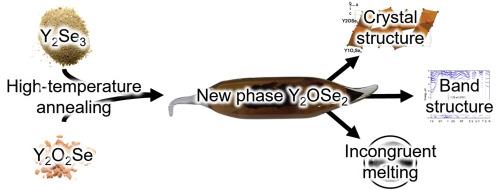Synthesis, crystal and electronic structure of Y2OSe2
IF 3.5
3区 化学
Q2 CHEMISTRY, INORGANIC & NUCLEAR
引用次数: 0
Abstract
Y2OSe2, a novel phosphor matrix, was first synthesized via sintering/melt crystallization of Y2Se3 and Y2O2Se precursors. Guided by LLM predictions (accurately forecasting synthesis at 800–1000 °C and incongruent melting ∼1450 °C), it crystallizes orthorhombically (Pnma, Gd2OSe2-type; a = 15.9748 (2), b = 3.89420 (5), c = 6.96804 (9) Å, V = 433.476 (10) Å3, Z = 4), contrasting the LLM's initial monoclinic (P21/c) prediction. Particles are oval with layered granular morphology (microhardness 290 ± 8 HV). The phase is stable under standard conditions and melts incongruently at 1470 ± 8 °C (forming melt + Y2O2Se), validating LLM thermal forecasts. Polycrystalline Y2OSe2 coexists in equilibrium with Y2Se3 or Y2O2Se. Raman spectra analysis, combining experimental data and DFT calculations, was performed. It has been shown that in the crystal structure of Y2OSe2, ion vibrations exhibit collective behavior in the low-frequency region, while the intense peaks above 110 cm–1 are mainly due to vibrations of specific types of ions. The simulation of the band structure and of the absorption spectrum reveals the origin of the onset of fundamental absorption, namely, the onset of direct transition at 1.76 eV into highly dispersive part of conduction band that contributes to the indirect bandgap, then the onset of more pronounced absorption above 3 eV at transitions to less dispersive part of conduction band. Four of five experimentally observed bands in the absorption spectrum are present in the simulated spectrum. Observed features are common to a variety of chalcogenides that were investigated in last two years.

Y2OSe2的合成、晶体及电子结构
以Y2Se3和Y2O2Se为前驱体,通过烧结/熔融结晶法制备了新型荧光粉基质Y2OSe2。在LLM预测(准确预测800-1000°C合成和不一致熔化~ 1450°C)的指导下,与LLM最初的单斜(P21/ C)预测相比,它具有正交结晶(Pnma, gd2ose2型;a = 15.9748 (2), b = 3.89420 (5), C = 6.96804 (9) Å, V = 433.476 (10) Å3, Z = 4)。颗粒呈椭圆形,呈层状颗粒状(显微硬度290±8hv)。该相在标准条件下是稳定的,在1470±8°C时不一致熔化(形成熔体+ Y2O2Se),验证了LLM热预测。多晶Y2OSe2与Y2Se3或Y2O2Se平衡共存。结合实验数据和DFT计算进行拉曼光谱分析。结果表明,在Y2OSe2的晶体结构中,离子振动在低频区表现出集体行为,而110 cm-1以上的强烈振动峰主要是由特定类型的离子振动引起的。通过对能带结构和吸收光谱的模拟,揭示了基吸收开始的起源,即在1.76 eV处直接跃迁到导带的高色散部分,形成间接带隙,然后在3 eV以上跃迁到导带的低色散部分时开始更明显的吸收。实验中观察到的吸收光谱中的5个波段中有4个出现在模拟光谱中。观察到的特征是近两年来研究的各种硫属化合物所共有的。
本文章由计算机程序翻译,如有差异,请以英文原文为准。
求助全文
约1分钟内获得全文
求助全文
来源期刊

Journal of Solid State Chemistry
化学-无机化学与核化学
CiteScore
6.00
自引率
9.10%
发文量
848
审稿时长
25 days
期刊介绍:
Covering major developments in the field of solid state chemistry and related areas such as ceramics and amorphous materials, the Journal of Solid State Chemistry features studies of chemical, structural, thermodynamic, electronic, magnetic, and optical properties and processes in solids.
 求助内容:
求助内容: 应助结果提醒方式:
应助结果提醒方式:


